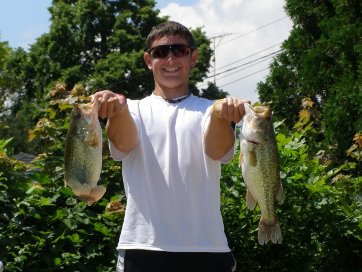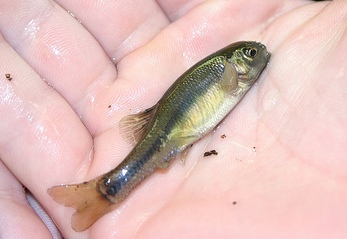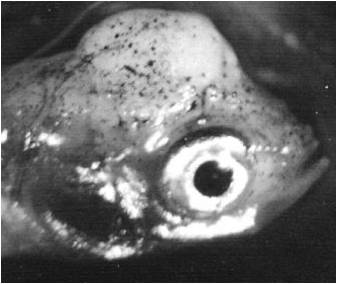Luxilus cornutus - BIO203
A Shiner's Interactions with Others
 Luxilus
cornutus is an organism that is quite low on the totem pole of the
food chain, thus it is a prey item for many other species. Most other
large freshwater fish that also occupy the same habitat are common
predators for the minnow. Some other fish species that reside in the
same habitat and prey on the shiner are
muskellunge,
northern pike,
and
largemouth bass (as seen in the picture to the above). Another
possible predator, although a little more rare, may be the
bald eagle. This bird will prey on the shiner that stays too close
to the surface for too long. A little more likely, however, is a
dead shiner that stays afloat, waiting to be used as another
organisms meal.
Luxilus
cornutus is an organism that is quite low on the totem pole of the
food chain, thus it is a prey item for many other species. Most other
large freshwater fish that also occupy the same habitat are common
predators for the minnow. Some other fish species that reside in the
same habitat and prey on the shiner are
muskellunge,
northern pike,
and
largemouth bass (as seen in the picture to the above). Another
possible predator, although a little more rare, may be the
bald eagle. This bird will prey on the shiner that stays too close
to the surface for too long. A little more likely, however, is a
dead shiner that stays afloat, waiting to be used as another
organisms meal.
The common shiner may not always be a prey item, however. It must get its meals from somewhere, and that is when it acts as a predator for a few organisms. As talked about in my nutrition page, the common shiner will feast on insect larvae, such as the mayfly, and many other plant organisms.
 Another
common interaction that is seen with the common shiner is
hybridized breeding with other species. Because the common
shiner uses the spawning beds of other species so often, it is
not uncommon for much hybridizing to occur. One species that the
common shiner readily hybridizes with, as well as uses their
spawning bed, is the
fathead minnow(seen above here). Another relationship quite like
this one is seen to be mutualistic between the shiner and the
hornyhead chub. The chub is thought to give the common shiner a
place to spawn and in return the shiner will provide some
protection to the new spawning bed of the group. This once again
will usually lead into more hybridizing between species.
Another
common interaction that is seen with the common shiner is
hybridized breeding with other species. Because the common
shiner uses the spawning beds of other species so often, it is
not uncommon for much hybridizing to occur. One species that the
common shiner readily hybridizes with, as well as uses their
spawning bed, is the
fathead minnow(seen above here). Another relationship quite like
this one is seen to be mutualistic between the shiner and the
hornyhead chub. The chub is thought to give the common shiner a
place to spawn and in return the shiner will provide some
protection to the new spawning bed of the group. This once again
will usually lead into more hybridizing between species.
A different relationship that is possessed between the common
shiner (as well as many other fish and minnow species) is that
between itself and a parasite. A very common parasite for the
common shiner is the nematode worm R. rotundicaudatum.
 This
parasite will have its peak intensity during the late spring and
taper down during summer. A prevalent intermediate host for this
parasite is the adult mayfly, and this may explain why common
shiners are so readily affected by this parasite. Numerous types
of worms infect a broad spectrum of fish species including the
one seen here. The picture seen to the right is of a fathead
minnow that has been infected by flatworms. The parasite has
infected the fishes brain and thus caused the swelling seen.
This
parasite will have its peak intensity during the late spring and
taper down during summer. A prevalent intermediate host for this
parasite is the adult mayfly, and this may explain why common
shiners are so readily affected by this parasite. Numerous types
of worms infect a broad spectrum of fish species including the
one seen here. The picture seen to the right is of a fathead
minnow that has been infected by flatworms. The parasite has
infected the fishes brain and thus caused the swelling seen.
Go back home, or learn some interesting facts about this little guy!